
Notelaea is a genus of flowering plants in the family Oleaceae and is endemic to Australia. Plants in the genus Notelaea are shrubs or small trees with leaves arranged in opposite pairs, flowers arranged in racemes in leaf axils with small sepals and 2 pairs of petals joined in pairs, 2 stamens and an ovary with 2 ovules with a 2-lobed stigma.

Commersonia is a genus of twenty-five species of flowering plants in the family Malvaceae. Plants in this genus are shrubs or trees, occurring from Indochina to Australia and have stems, leaves and flowers covered with star-like hairs. The leaves are simple, often with irregularly-toothed edges, the flowers bisexual with five sepals, five petals and five stamens and the fruit a capsule with five valves. The genus underwent a revision in 2011 and some species were separated from Commersonia, others were added from Rulingia.
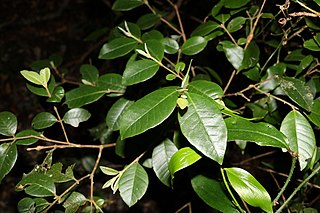
Lenwebbia is a genus of shrubs or small trees in the myrtle family Myrtaceae. The type species is Lenwebbia lasioclada.

Rhodomyrtus is a group of shrubs and trees in the family Myrtaceae, described as a genus in 1841 and native to southern China, the Indian subcontinent, Southeast Asia, Melanesia, and Australia.

Gossia bidwillii, known as the python tree is a rainforest myrtle of eastern Australia. The usual habitat is the drier rainforest areas. The range of natural distribution is from the Hunter River in New South Wales to Coen in far northern Queensland.

Melaleuca williamsii is a plant in the myrtle family, Myrtaceae and is endemic to an area between north-eastern New South Wales and south eastern Queensland in Australia. It is a distinctive shrub with stiff branches, silvery new growth, prickly leaves and spikes of purple flowers in late spring. It is classified as a vulnerable species under the Australian Government Endangered Species Protection Act.

Notelaea longifolia is a very common shrub or small tree in eastern Australia. Occurring in or adjacent to rainforest from Mimosa Rocks National Park to Bamaga in far north Queensland. Common names include large mock-olive or long-leaved-olive. An attractive ornamental plant.
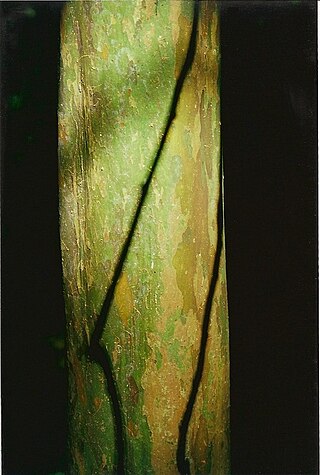
Gossia is a genus of rainforest trees in the myrtle family first described as a genus in 2003 by Neil Snow, Gordon Guymer and Sawvel. It is native to northeastern Australia as well as several islands of Papuasia and New Caledonia.

Rhodamnia whiteana, known as the cliff malletwood or White's malletwood is a sub-tropical rainforest plant of eastern Australia. It was first formally described in 1986 by Gordon Guymer and Laurence Jessup from a specimen collected from Mount Cordeaux.
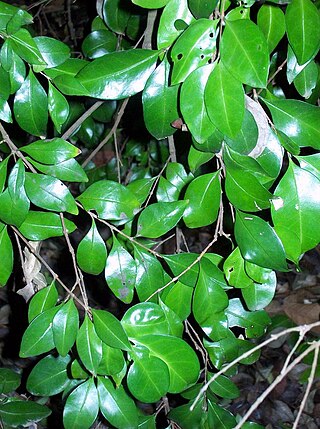
Gossia fragrantissima, the sweet myrtle or small-leaved myrtle, is a shrub or small tree of eastern Australia. A plant with a ROTAP rating of 3EC-, endangered by extinction. Found in sub tropical rainforests near streams, from near Woodburn, New South Wales to Nambour in south eastern Queensland. It features fragrant flowers, hence the specific epithet fragrantissima. White flowers grow from October to February.

Notelaea ligustrina, known as the privet mock olive, native olive, doral or silkwood, is a plant in the olive family, found in southeastern Australia. It is known to grow in and near rainforests south of Monga National Park in New South Wales, and into Victoria and the island state of Tasmania. The specific epithet ligustrina refers to the Privet, which it resembles.
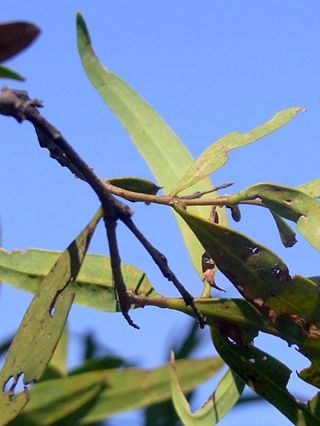
Notelaea microcarpa is a bush or small crooked tree from the olive family, found in eastern Australia. Two varieties are recognised; var. microcarpa, the velvet mock olive and var. velutina known as the gorge mock olive.

Notelaea lloydii, commonly known as Lloyd's olive, or Loyd's native olive, is a species of flowering plant in the family Oleaceae and is endemic to Queensland. It is a shrub with leathery, linear or slightly sickle-shaped leaves, pale yellow or cream-colored flowers with 4-lobed petals, 2 stamens and a glabrous ovary. The fruit is a dark blue drupe.

Mischocarpus ailae, known as the woolly pear-fruit is a rainforest tree of north eastern New South Wales and south east Queensland, Australia. These southern populations comprising M. ailae were previously included in Mischocarpus lachnocarpus.

Pandorea floribunda is a species of flowering plant in the family Bignoniaceae and is endemic to eastern Australia. It is similar to Pandorea pandorana but the leaflets are egg-shaped, 30–80 mm (1.2–3.1 in) long and 15–50 mm (0.59–1.97 in) wide and the flowers are pale yellow to cream-coloured.
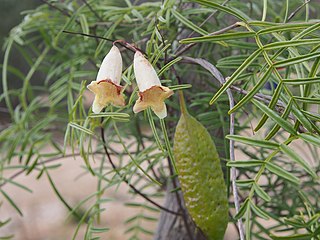
Pandorea linearis is a species of flowering plant in the family Bignoniaceae and is endemic to Queensland. It is similar to Pandorea pandorana but has nine to thirteen linear leaflets, the lateral leaflets 11–42 mm (0.43–1.65 in) long and 1.5–6 mm (0.059–0.236 in) wide.
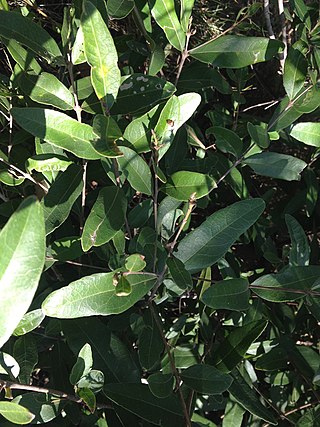
Notelaea ipsviciensis, also known as the Cooneana Olive, is a species of flowering plant in the olive family that is endemic to Australia.

Notelaea johnsonii, also known as the veinless mock olive, is a species of flowering plant in the olive family that is endemic to Australia.

Notelaea linearis, also known as the native olive, is a species of flowering plant in the olive family that is endemic to Australia.

Notelaea punctata, also known as the large mock-olive, is a species of flowering plant in the olive family that is native to eastern Queensland, Australia.




















